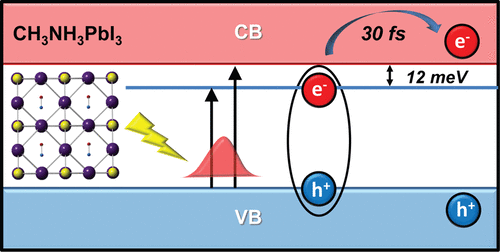当前位置:
X-MOL 学术
›
ACS Photonics
›
论文详情
Our official English website, www.x-mol.net, welcomes your feedback! (Note: you will need to create a separate account there.)
Direct Observation of Ultrafast Exciton Dissociation in Lead Iodide Perovskite by 2D Electronic Spectroscopy
ACS Photonics ( IF 7 ) Pub Date : 2017-12-22 00:00:00 , DOI: 10.1021/acsphotonics.7b01025 Ajay Jha 1 , Hong-Guang Duan 1, 2, 3 , Vandana Tiwari 1, 4 , Pabitra K. Nayak 5 , Henry J. Snaith 5 , Michael Thorwart 2, 3 , R. J. Dwayne Miller 1, 3, 6
ACS Photonics ( IF 7 ) Pub Date : 2017-12-22 00:00:00 , DOI: 10.1021/acsphotonics.7b01025 Ajay Jha 1 , Hong-Guang Duan 1, 2, 3 , Vandana Tiwari 1, 4 , Pabitra K. Nayak 5 , Henry J. Snaith 5 , Michael Thorwart 2, 3 , R. J. Dwayne Miller 1, 3, 6
Affiliation

|
The unprecedented success of hybrid organic–inorganic lead halide perovskites in photovoltaics motivates fundamental research to unravel the underlying microscopic mechanism for photoinduced charge generation. Recent studies suggest that most photoexcitations in perovskites are free charge carriers, although the contribution of the electron–hole pairs (i.e., excitons) at room temperature has been a matter of debate. We have employed ultrafast two-dimensional (2D) electronic spectroscopy to directly probe the elementary optical excitation of CH3NH3PbI3 thin films with ∼16 fs temporal resolution. We distinctly capture the ultrafast dissociation of excitons to the charge carriers at room temperature and at 180 K. Interestingly, we also observe that the coherent oscillations of the off-diagonal signals in the 2D electronic spectra live for ∼50 fs at room temperature. The entropy-driven dissociation of excitons to charge carriers happens within the electronic dephasing time scale and is favored by the low exciton binding energy, which we determine to be ∼12 meV at room temperature. This ultrafast dissociation of excitons to charge carriers can be one of the important contributions to the high efficiency of perovskite-based photovoltaics.
中文翻译:

二维电子光谱法直接观察碘化钙钛矿中超快激子的解离
有机-无机卤化铅钙钛矿杂化材料在光伏领域的空前成功促使基础研究揭示了光诱导电荷产生的微观机理。最近的研究表明,钙钛矿中的大多数光激发都是自由电荷载体,尽管室温下电子-空穴对(即激子)的贡献一直存在争议。我们已使用超快二维(2D)电子光谱法直接探测CH 3 NH 3 PbI 3的基本光激发时间分辨率约为16 fs的薄膜。我们在室温和180 K下清晰地捕获了激子与电荷载流子的超快解离。有趣的是,我们还观察到二维电子光谱中非对角线信号的相干振荡在室温下的寿命约为50 fs。激子与电荷载体的熵驱动解离发生在电子移相时间范围内,并且受低激子结合能的影响,我们确定其在室温下约为12 meV。激子与电荷载流子的超快解离可能是钙钛矿型光伏高效率的重要贡献之一。
更新日期:2017-12-22
中文翻译:

二维电子光谱法直接观察碘化钙钛矿中超快激子的解离
有机-无机卤化铅钙钛矿杂化材料在光伏领域的空前成功促使基础研究揭示了光诱导电荷产生的微观机理。最近的研究表明,钙钛矿中的大多数光激发都是自由电荷载体,尽管室温下电子-空穴对(即激子)的贡献一直存在争议。我们已使用超快二维(2D)电子光谱法直接探测CH 3 NH 3 PbI 3的基本光激发时间分辨率约为16 fs的薄膜。我们在室温和180 K下清晰地捕获了激子与电荷载流子的超快解离。有趣的是,我们还观察到二维电子光谱中非对角线信号的相干振荡在室温下的寿命约为50 fs。激子与电荷载体的熵驱动解离发生在电子移相时间范围内,并且受低激子结合能的影响,我们确定其在室温下约为12 meV。激子与电荷载流子的超快解离可能是钙钛矿型光伏高效率的重要贡献之一。



























 京公网安备 11010802027423号
京公网安备 11010802027423号